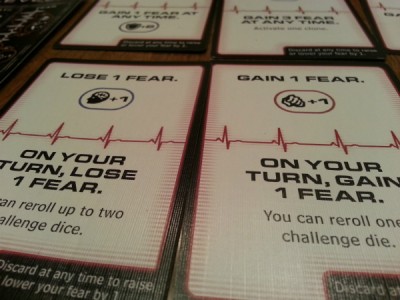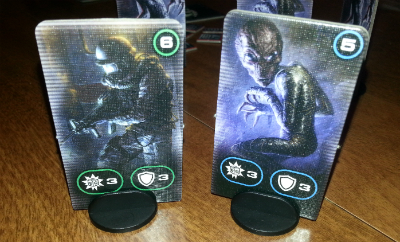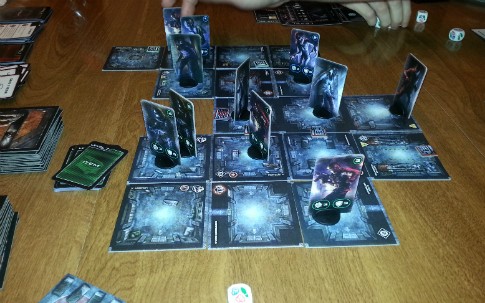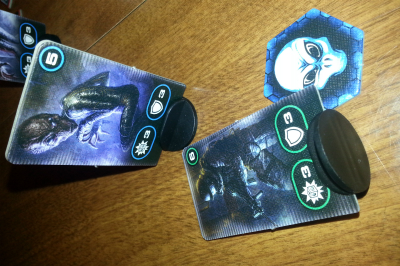Remember that time everyone was convinced Area 51 was the pinnacle of secret military bases? Unfortunately, it’s not true. It’s never been true. It’s all an elaborate decoy. They want you to know about Area 51. Heck, they did everything they could to make sure you knew about it. Because there’s this other place. It has the actual aliens you’re looking for – but you don’t want to be there. There being Subterra Bravo.
See, Subterra Bravo isn’t on any map or any official paperwork; there’s no trace whatsoever on Google Earth. If you know about Subterra Bravo, either you’re working there, or you’re one of those unlucky few the government sold out and delivered to their secret laboratories.
Yes, they know all about the aliens, but they struck a bargain: they get technology in exchange for some tasty, tasty, humans to experiment – or snack – on. Their call, really.
We’re sorry to report that you do not, in fact, work there.
The Premise
In Level 7: Escape, you and up to three friends are test subjects trapped in the underground research facility known as Subterra Bravo, a labyrinthine base teeming with aliens and guards. Both are out to get you, because you’ve escaped your cell and are running free throughout the facility. Your task is to find the way up to ground level. You and your friends work together to explore the facility and take on guards, aliens, and the environment. Cooperation with your friends is all you have, as Subterra Bravo doesn’t officially exist, and no one on the outside will come for you.
The Rules
Level 7 is a scenario-based board game (think a cross between D&D and a board game). It’s recommended that you play the scenarios sequentially to watch the story properly unfold. The first level serves as a tutorial, with some of the game components out of use. As such, setup will vary considerably depending on the scenario being played. You’ll want to consult the booklet for the necessary pieces.
Regardless of which level you choose, however, initial character creation is the same. Players choose one of four functionally identical player sheets. Each player has the same basic stats (Intelligence, Attack, Defense, and Speed). Then, players each draw two skill cards that give bonuses to different abilities used throughout the game. (One card, for instance, allows you to take an extra item each time you knock out a guard.)
Each player also has a fear track to chart their adrenaline. The fear track is the primary means of altering your base stats. Scary events, like being attacked, cause the fear track to increase. A higher fear amount gives players bonuses to Speed and Attack, while a lower fear gives bonuses to Intelligence. Also, the aliens are attracted to adrenaline, and the more of it you put out, the more they want to come after you (as opposed to your friends).
 At the beginning of each player’s turn, they draw up to their current hand size of adrenaline cards. These cards can be played three ways:
At the beginning of each player’s turn, they draw up to their current hand size of adrenaline cards. These cards can be played three ways:
- To give you or an adjacent player the top bonus
- To give you or an adjacent player the bottom bonus
- To move your fear track up or down by one.
Be careful though – the adrenaline cards also serve as your health. Should you run out of cards, you get knocked unconscious, causing you to lose a turn and have your max hand size decrease. If this occurs too many times, you’ll be beyond saving.
Next, the player explores a room by revealing a tile. Depending on the scenario, you may be searching for a specific set of tiles. In Scenario 1, for example, you’re looking for the elevator piece. A player may also choose to stay put, or to attack an alien or guard on their square. Attacks in Level 7 are simple – you roll special dice included in the game to determine who comes out on top.
Finally, at the end of each player’s turn they draw an event card. Each event card details a particular challenge that you may have had to overcome that turn, whether a guard or alien spawns somewhere on the map, and if the aliens and/or guards go on the offense.
Play continues in rounds until all players have successfully reached the end of the Scenario, or they have become delicious alien-kabobs.
The Horror, The Horror!
Some games take you to scenic islands, or to other realms, or to the very edges of the known universe.
 Some other games lock you in blood-stained basement with adrenaline-slurping aliens and trigger-happy guards.
Some other games lock you in blood-stained basement with adrenaline-slurping aliens and trigger-happy guards.
Let’s just put it this way: Level 7 is no scenic tour – unless you like biolabs and dark corridors. Level 7 successfully delivers a survival horror game that doesn’t involve Cthulhu or zombies. This is science fiction horror survival – think Aliens or The X-Files. This is the kind of place that Fox Mulder was warning us about all those years.
True to form, the game manages to feel dark and foreboding. Whether you’re inspecting the grim character portraits or the gruesome, bloodstained room tiles, there is a sense that something very wrong is happening. And you’re at the center of it. The game compounds this feeling with progressive challenges. Each of the seven scenarios increases in difficulty as you work your way towards freedom, and combined with the unpredictability of the event cards, you have a game that keeps you on your toes. It will likely take many attempts at the higher levels to achieve victory. Don’t give up – otherwise the aliens win.
We highly suggest playing with the same group as long as you can for full effect, even if you have to stretch it over multiple game sessions. It’s not a requirement to enjoy the game, but it will add to the storytelling aspect. Propelling the plot is one of the mainstays of a scenario-based game. As with tabletops proper, the story is paramount to enjoying the game. These hybrids of storytelling and standard board games aren’t especially new, but unlike games such as Castle Ravenloft or Mansions of Madness, this is the first noteworthy one without a mystical tint to it. It’s quite the opposite, actually. Level 7’s selling point, aliens aside, is the realism it strives for – and achieves. Sci-fi Immersionists will have their fill of surrealism, even if the characters themselves aren’t fleshed out in a traditional sense.
Accessing Freedom
How does one survive Level 7 all the way through? We’d love to say that a well-armed, well-planned strike attack would do it. But you and your teammates are not that group. Your group is just happy to be alive (for now). For several scenarios, it’s difficult to even attain items, let alone a notable weapon. No, in Subterra Bravo stealth and avoidance are the long-term keys to success, which initially may seem contrary to the flow of the game. Strikers may get a little frustrated at that, because brute force isn’t usually the best way to get through the maps. In fact, attacking outright can be difficult and is often penalized by the game.
To accomplish a more clandestine approach, discussion of strategy between players is essential. Thought and preparation are two words a Tactician lives for. As the game becomes more taxing you will be glad they’re working with you instead of the alien overlords.
Of course, a Tactician’s skills will only get you so far: so much of what can happen each turn depends on the randomness of the event cards. You will have to continually re-examine your plans. This should’t give you a false idea that you should just “wing it” though. Daredevils could feel somewhat handicapped at times, though there is certainly room for risky actions. Gambles are not uncommon, and they may even be necessary to winning at the right moments.
Moreover, Socializers will like the interaction of this co-op, but it may be a little too involved for them to play more than once or twice before getting restless or bored with it. This could be more common in early sessions as you’ll probably have to reference the rules regularly as you acclimate. They are written are decently enough, but some rules can (and do) get buried. If there is one thing that will turn a Socializer off to a game fast, it’s constant rule checks.
The Takeaway
Level 7 is not for the faint of heart. It isn’t that the game is overly long or needlessly complicated. Rather, it’s the combination of increasing difficulty and much of your success resting on the events of each turn. But for folks who enjoy a moderate-length co-op game and/or who enjoy survival horror settings, this game will not disappoint. While we wish the rules were a little clearer and the adrenaline cards a little thicker, these are minor detractors to a game that so eloquently presents a setting of apprehension and dread. The scenario-based plots, randomness of the event cards, and unpredictable dice rolls provide you with a game that certainly maintains both theme and replay value many times over.
So, does your team escape Subterra Bravo? Are the alien’s plans foiled?
Well, as they say:
Cardboard Republic Snapshot Scoring (Based on scale of 5):
Artwork: 4
Rules Clarity: 2.5
Replay Value: 5
Physical Quality 3
Overall Score: 4.0



